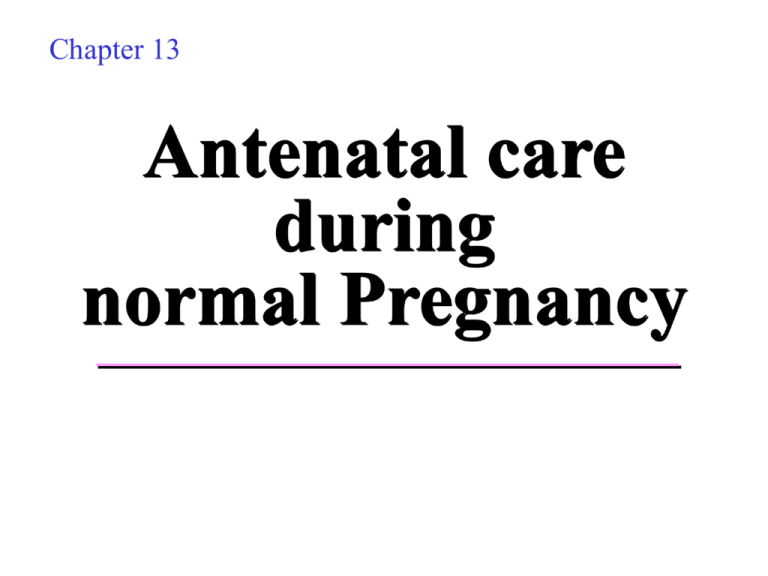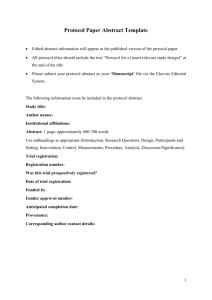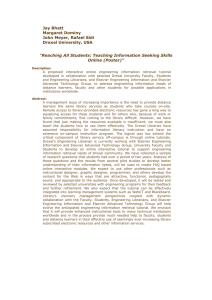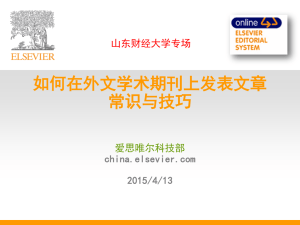
Chapter 13
Antenatal care
during
normal Pregnancy
Copyright © 2005 by Elsevier, Inc. All rights reserved.
Confirmation of pregnancy
The diagnosis of pregnancy has traditionally
been based on symptoms and signs
These signs and symptoms are grouped
into three classification:
1. Presumptive indication
2. Probable indications
3. Positive indications
Copyright © 2005 by Elsevier, Inc. All rights reserved.
Presumptive Indication
mainly subjective changes that may be
caused by conditions other than
pregnancy.
• Nausea and Vomiting
• Fatigue
• Amenorrhea
• Urinary frequency
• Breast and skin changes
• Vaginal and cervical color
changes
• Quickening (Fetal
movement)noted between 1620 GW
Copyright © 2005 by Elsevier, Inc. All rights reserved.
Probable Indication
these are objective findings strongly
indicate pregnancy but can’t be
rely on because it might be caused
by another condition.
–Abdominal enlargement
–Cervical softening (Goodell’s
sign, Hegar’s sign)
–Uterine changes
(ballottement, Braxton Hicks
Contractions, Palpation of the
fetal outline, uterine souffle)
–Pregnancy tests
(radioimmunoassay)
Copyright © 2005 by Elsevier, Inc. All rights reserved.
Positive Indications
those caused only by pregnancy.
–Fetal movements by examiner
–Visualization of the fetus
(ultrasonography)
–Auscultation of fetal heart
sounds (can be heard by
fetoscope by 18-20 Gwks or at
10 Gwks by doppler. Normalrd
range is (110-160 bpm at 3
trimester)
Copyright © 2005 by Elsevier, Inc. All rights reserved.
Preconception Visits
• Ideally take place several months
before conception
• Obtain complete health history
and physical examination
• Evaluation of health problems
such as DM and HTN and their
treatment
• Assessment of any medication the
woman is taken and their effect
on pregnancy
• Obese woman should obtain help
to loose weight before pregnancy
Copyright © 2005 by Elsevier, Inc. All rights reserved.
Preconception visit continued
.
Instructe woman regarding:
• Rubella vaccine if not immunized
• Hepatitis vaccine
• Avoidance of common teratogens or
other harmful substances
• Importance of folic acid supplement 0.4
mg dose before conception daily
• Stop smoking and alcohol consumption
Copyright © 2005 by Elsevier, Inc. All rights reserved.
Initial visit
1.History:
• Obstetric history(e.g GTPAL)
• Menstrual history, LMP, EDD
• Contraceptive history
• Medical and surgical history
• Family health History(for chronic
disease and genetics)
• Partner's Health history(genetic
abnormalities alcohol and tobacco
use,blood type and RH )
• Psychosocial history
Copyright © 2005 by Elsevier, Inc. All rights reserved.
• 2.Physical Examination
• Vital signs
• Head to toe assessment
• 1.Cardivascular system(venous
congestion and edema)
• 2.Musculoskeletal system
-posture and gait
-Height and weight
-Pelvic measurement
-abdomen
Copyright © 2005 by Elsevier, Inc. All rights reserved.
3.Neurologic assessment
4.Gasrointestinal
5. Integumentary system
6.Endocrine system(thyroid
enlargement)
Copyright © 2005 by Elsevier, Inc. All rights reserved.
• 7.Urinary System
•
•
•
•
Protein
Glucose
Ketones
Bacteria
• 8.Reproductive system
• Breasts
• External and internal reproductive
organs
Copyright © 2005 by Elsevier, Inc. All rights reserved.
- Laboratory data: see
-.
table 13-1 page 268
- Risk assessment
box13-3 page 267
Copyright © 2005 by Elsevier, Inc. All rights reserved.
Common laboratory tests
• Blood group,hb and HCt,RH
•
•
•
•
•
•
•
•
•
•
Venereal disease
Rubella titer
Tuberculin test for tuberculosis
Genetic testing for high risk woman
Hepatitis B
HIV
Urinalysis
Pap smear and cervical culture
AFP
Glucose challenge test
Copyright © 2005 by Elsevier, Inc. All rights reserved.
Measuring the Uterus
Fig. 13-10
Copyright © 2005 by Elsevier, Inc. All rights reserved.
High-Risk factors in pregnancy:
- Age: <16 or >35 years
- Low socioeconomic status
- Multiparity > 4 pregnancies
- Weight obesity and underweight
- Height < 152 cm
- Smoking or alcohol or unprescribed
drugs
- Birth of previous infant > 4000g
- Previous fetal or neonatal death
- RH sensitization
- DM, cardiac disease, renal
disease,thyroid problems
Copyright © 2005 by Elsevier, Inc. All rights reserved.
- infections
Subsequent assessment
• Visit sequence
• Every 4 weeks from
conception to 28GW
• Every 2to3 weeks from
29to 36 GW
• Every week from 37GW to
birth
Copyright © 2005 by Elsevier, Inc. All rights reserved.
Assessment in subsequent
visits
• Vital signs
• Pattern of weight gain
• Urinalysis
• Fundus height
• Leopold's maneuver
• FHR
• Fetal activity(Kick counts)
Copyright © 2005 by Elsevier, Inc. All rights reserved.
• Test for Isoimmunisation for RH(26-28GW)
• Pelvic examination
• Signs of labor
• Common discomfort see page
270-271 for these discomfort and
teaching for woman
• Danger signs
• Ultra sound Screen(12-20GW)
• Glucose screen(28GW) glucose
challenge test is done if the test
result is 140mg/dl or higher GTT
is done
Copyright © 2005 by Elsevier, Inc. All rights reserved.
Common discomforts of
pregnancy:
Nausea and vomiting,
Heart burn
Backache
Round ligament pain
Urinary frequency
Varicosities
Copyright © 2005 by Elsevier, Inc. All rights reserved.
Danger Signs During
Pregnancy
• Vaginal bleeding, with or without
discomfort
• Rupture of membranes
• Swelling of the fingers, puffiness of the
face or around the eyes
• Continuous, pounding headache
• Visual disturbances (blurred vision,
dimness, spots)
Copyright © 2005 by Elsevier, Inc. All rights reserved.
•
•
•
•
•
Persistent or severe abdominal pain
Chills or fever
Painful urination
Persistent vomiting
Changes in frequency or strength of
fetal movements
• Signs of preterm labor: contraction,
backache, pelvic pressure
Copyright © 2005 by Elsevier, Inc. All rights reserved.
*Teaching Health Behaviors
1. Bathing
-protect from infection and enhance
comfort
-avoid stay in sauna or hot tub more
than 10-15 min because of
hyperthermia particularly during first
trimester
-shouldn't expose to temperature of
37.8 or higher
Copyright © 2005 by Elsevier, Inc. All rights reserved.
2. Douching
-avoid douching because it leads to
infection and preterm labor
3. Breast care
-avoid soap in nipple and wear
supportive bra
-avoid nipple stimulation if she has
a history or signs of preterm labor
Copyright © 2005 by Elsevier, Inc. All rights reserved.
5. Exercise
-exercise in moderation for 30
minute daily
-walking is ideal exercise
-exercise that require balance or may
cause injury or in supine position is
not safe
-avoid becoming overheated during
exercise
-should stop exercise and seek
medical advice if she has chest
pain,dizziness,headach,decreased
fetal movement or signs of labor
Copyright © 2005 by Elsevier, Inc. All rights reserved.
• 4. Clothing
-comfortable and non
constricting clothes
-avoid high heel shoes
Copyright © 2005 by Elsevier, Inc. All rights reserved.
6. Sleep and rest
7. Nutrition
8. Sexual activity(safe any time
for healthy woman)
9.Employment
-avoid fatigue and take a rest
period
-avoid fetotoxic environment
Copyright © 2005 by Elsevier, Inc. All rights reserved.
10. Travel
-travel by car is safe but travel by plane up
to 36 weeks
11. Immunization
-live vaccine is contraindicated such as
MMR
-inactivated vaccine is considered safe
such as tetanus and influenza
12. Drug over the counter
13. Complementary therapy
14. Smoking ,alcohol, addiction
Copyright © 2005 by Elsevier, Inc. All rights reserved.





